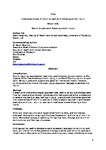Lived experiences of return to paid work following a brain injury
| dc.contributor.author | Beaulieu, Karen | |
| dc.date.accessioned | 2019-07-19T10:26:14Z | |
| dc.date.issued | 2019-08-01 | |
| dc.identifier.issn | 0308-0226 | |
| dc.identifier.issn | 1477-6006 | |
| dc.identifier.other | ARTN 0308022619860980 | |
| dc.identifier.uri | http://hdl.handle.net/10026.1/14656 | |
| dc.description.abstract |
Introduction: Due to resulting psychosocial, cognitive, psychological, communication and/or physical difficulties following a brain injury, it is often difficult to return to paid work. Being in paid work is generally good for individuals’ health; however, currently only one third of the brain injury population manage to achieve this return. Method: A descriptive phenomenological approach was used to collect and analyse data from 10 male and six female individuals who had sustained either a moderate or severe traumatic or acquired brain injury. Unstructured interviews explored their experiences of return to paid work. Data analysis resulted in synthesised descriptions of their return to paid work lived experiences following a brain injury. Findings: Sixty-one meaning units were established from the data, and six themes emerged: coping with ongoing difficulties; expectation and timing of return to work; workplace colleague reactions; things that help; change and return to work options; and feelings of success. Conclusion: Findings can be used to develop a more consistent approach to return to paid work, and will inform future occupational therapy practice and return to paid work rehabilitation. Occupational therapists need to support these individuals to cope with the ongoing difficulties facing them, especially in relation to fatigue, memory and transportation difficulties. | |
| dc.format.extent | 658-665 | |
| dc.language | en | |
| dc.language.iso | en | |
| dc.publisher | SAGE Publications | |
| dc.subject | Brain injury | |
| dc.subject | return to work | |
| dc.subject | occupational therapy | |
| dc.title | Lived experiences of return to paid work following a brain injury | |
| dc.type | journal-article | |
| dc.type | Journal Article | |
| plymouth.author-url | https://www.webofscience.com/api/gateway?GWVersion=2&SrcApp=PARTNER_APP&SrcAuth=LinksAMR&KeyUT=WOS:000479789700001&DestLinkType=FullRecord&DestApp=ALL_WOS&UsrCustomerID=11bb513d99f797142bcfeffcc58ea008 | |
| plymouth.issue | 11 | |
| plymouth.volume | 82 | |
| plymouth.publication-status | Published | |
| plymouth.journal | British Journal of Occupational Therapy | |
| dc.identifier.doi | 10.1177/0308022619860980 | |
| plymouth.organisational-group | /Plymouth | |
| plymouth.organisational-group | /Plymouth/Faculty of Health | |
| plymouth.organisational-group | /Plymouth/Research Groups | |
| plymouth.organisational-group | /Plymouth/Research Groups/Institute of Health and Community | |
| plymouth.organisational-group | /Plymouth/Research Groups/Plymouth Institute of Health and Care Research (PIHR) | |
| plymouth.organisational-group | /Plymouth/Users by role | |
| dcterms.dateAccepted | 2019-06-04 | |
| dc.rights.embargodate | 2019-9-13 | |
| dc.identifier.eissn | 1477-6006 | |
| dc.rights.embargoperiod | Not known | |
| rioxxterms.versionofrecord | 10.1177/0308022619860980 | |
| rioxxterms.licenseref.uri | http://www.rioxx.net/licenses/all-rights-reserved | |
| rioxxterms.licenseref.startdate | 2019-08-01 | |
| rioxxterms.type | Journal Article/Review |


